Featured Articles
- 01 Windows 10 Not Detecting Hard Drive But BIOS Does
- 02 Hard Drive Not Showing Up
- 03 External Hard Drive Not Showing Up
- 04 External Hard Drive Not Showing Up on Mac
- 05 WD Hard Drive Not Showing Up
- 06 Seagate External Hard Drive Not Working/Detected
- 07 SSD Not Showing Up
- 08 M.2 Not Showing Up
- 09 NVME Drive Not Showing Up
- Reading Duration: 3-5 minutes
- Applies to: Fix a used and new hard drive not showing up, internal or external HDD/SSD not detected on Windows PCs.
Are your hard drives new or old, internal or external, not showing up in File Explorer or Disk Management? Follow this guide, and you'll learn why your hard drive not showing up and how to make your hard disk show up again in Windows 10/8/7 without losing data.
Refer to this post to find the suitable fixes in your case, and learn the detailed steps to fix a hard drive not showing up error on a Windows PC.
Why Is My Hard Drive Not Showing Up
Note: If your hard drive is physically damaged or broken, send it to a local repair center or its manufacturer for repair. Fixes that are shown below only work to fix logical errors that prevent your drive from showing up on computers.
Your hard drive may not be showing up due to connection issues, lack of power, an incorrect or missing drive letter, outdated drivers, a problem with the drive itself (such as a corrupted file system or physical damage), or something else, as shown below:
| Symptoms of Disk Not Showing Up | Causes of Hard Drive Not Showing Up |
|---|---|
|
|
All these errors can be fixed, and follow the solutions in the next two parts to make your internal or external hard drive show up on Windows again. We have a video tutorial on solving the problem of the hard drive not showing up in Windows 11/10/8/7. You can follow this video tutorial solution.

Install the professional and trusted hard drive recovery software on your computer to easily restore data from a problematic HDD.
Fix (Old/New) Hard Drive Not Showing Up in 6 Ways
Applies to: Fix internal or new hard drive not showing up, not recognized, or hard drive not detected errors in Windows 10/8/7.
In this part, we've compiled 6 ways for you to try. Pick an appropriate method according to the current state of your hard drive, and follow the tutorial to make your drive show up again:
| Workable Solutions | Step-by-step Troubleshooting |
|---|---|
| Fix 1. Change Disk Connection | Check the cables. If the power cable or SATA cable is broken, replace the cable with a new one...Full steps |
| Fix 2. Format Hard Drive to NTFS | Press Windows + X, click Disk Management, and right-click on your hard drive to select Format...Full steps |
| Fix 3. Restore Data and Create New Partition | Launch EaseUS hard drive recovery software, select the hard disk, and scan the lost files...Full steps |
| Fix 4. Change Drive Letter | In Disk Management, select the disk marked as New Volume or the partition with no drive letter...Full steps |
| Fix 5. Update Disk Driver | Right-click This PC > Manage > Device Manager > Disk drives, and find the hard drive...Full steps |
| Fix 6. Initialize the Hard Disk | Go to This PC > Manage > Disk Management, right-click the disk, and choose Initialize Disk...Full steps |
Fixes 1, 2,3, 4, and 5 are worth trying for the used hard drive. If your new hard drive is not showing up, try fix 3 and fix 6.
Let's start fixing the hard drive not showing up error by yourself:
Fix 1. Change Disk Connection to Fix HDD Not Showing Up in File Explorer
Applies to: Fix internal hard drives or a new hard drive that is not showing up in File Explorer or Disk Management.
Connection issues usually result from a problematic cable or loose connection. Here's how to fix your hard drive connection and make it show up on your computer. In this way, you can also solve hard drive files not showing problems.
Step 1. Check the cables. If the power cable or SATA cable is broken, replace the cable with a new one.
Step 2. Unplug and plug your hard drive tightly via the SATA cable and power cable.
Step 3. Restart your PC to check if the hard drive shows up.
Fix 2. Format Hard Drive to NTFS to Fix Hard Disk Not Detected with RAW or Corrupted File System
Applies to: Fix a hard drive not showing up caused by an unsupported, RAW, or corrupted file system.
When your hard drive is displaying as RAW or as "*Others" in Disk Management, it means that your hard drive contains a file system error.
In this case, the best solution is to format the drive to a supported file system. Here is how to do it:
Step 1. In Windows 10/8, Press the Windows + X keys and click "Disk Management".
In Windows 7, right-click the Start icon and select "Search". Type disk management and click on it.
Step 2. Find and right-click on your hard drive, and select "Format".
Step 3. Set the file system as NTFS, tick "Perform a quick format", and click "OK" to start formatting the drive.
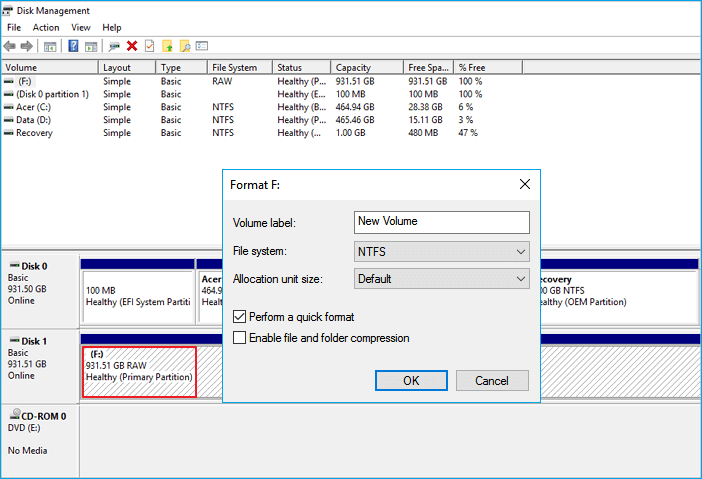
Note: As formatting causes data loss, don't forget to use EaseUS data recovery program in fix 3 to bring back all your hard drive data after making the drive show up.
Fix 3. Restore Data and Create New Partition to Fix Not Showing Unallocated Hard Drive
Applies to: Fix hard drive not showing up but displays as unallocated or unknown, new hard drive shows as not initialized in Disk Management.
If a used hard disk suddenly becomes unallocated, it could be due to accidental deletion, a virus attack, or other unknown reasons that cause partition loss on your disk.
In this case, you should recover data from the unallocated space first. Then, create a new volume(s) on the disk to make the hard drive show up.
# 1. Recover Data from Unallocated Hard Drive
Professional hard drive recovery software - EaseUS Data Recovery Wizard can fully scan a lost partition and bring back your files from unallocated hard drive space.
EaseUS Data Recovery Software
- Recover deleted files from SSD, HDD, Recycle Bin, memory cards, flash drives, digital cameras, and camcorders
- Support RAW drive recovery, lost partition recovery, and RAID recovery
- Repair corrupted JPEG/PNG files, videos, and documents after data recovery on storage devices
The software will mark the unallocated space on your disk as a lost partition so you can directly select to scan and find everything on the drive:
Step 1. Select the drive where you lose your data and click "Search for Lost Data".
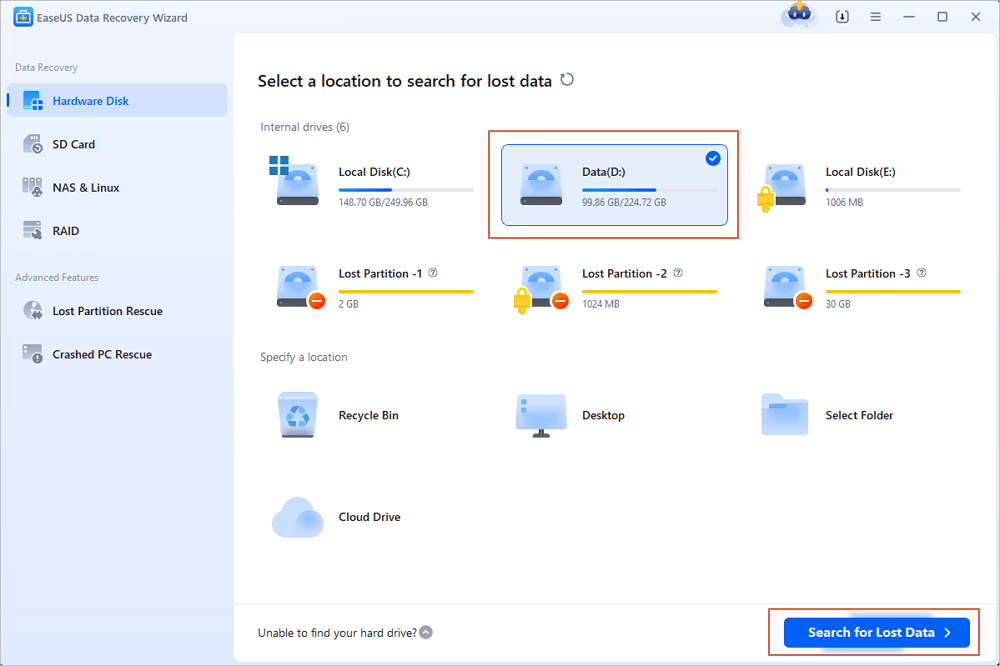
Step 2. Use "Filter" or "Search" to find the lost files when the scan completes.
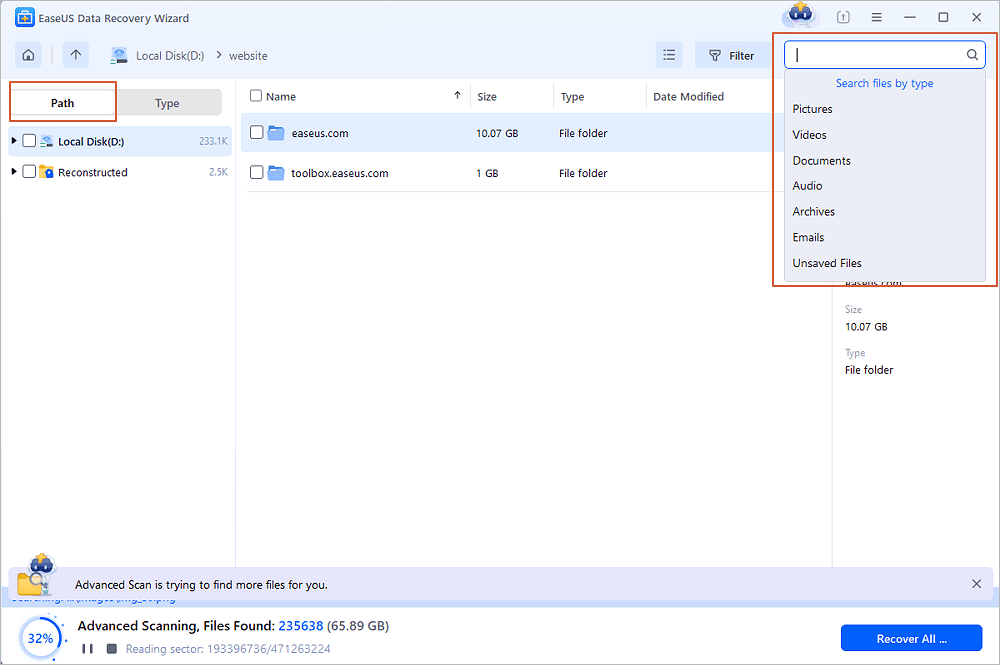
Step 3. Select all the files you want and click "Recover". Then, browse another secure location to save them.
💡Tip: You can restore data on the local disks, external hard drives, and also the cloud storage.
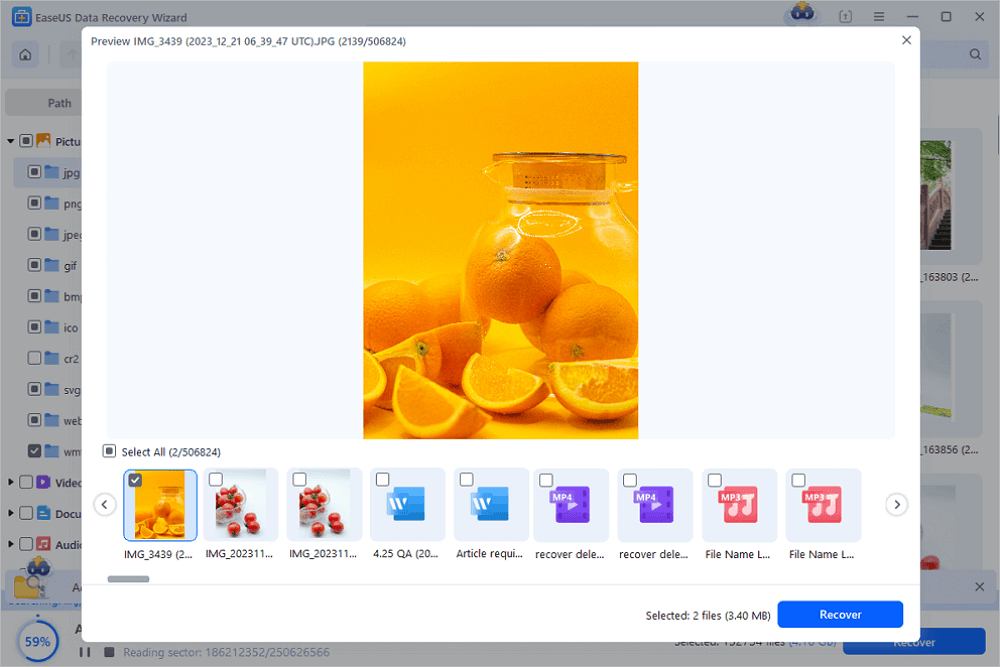
Make sure to save the recovered files to another secure location before making the hard drive show up and ensuring it's safe to save files again. If you cannot solve this case on your own, you can also turn to data recovery services.
Consult with EaseUS data recovery experts for one-on-one manual recovery service. We could offer the following services after a FREE diagnosis
- Fix HDD, SSD, external hard drive, USB flash drive, and pen drive issues
- Fix disks that cannot be read or accessed because of bad sectors
- Fix disks that become GPT-protected partitions
- Repair damaged RAW drive that needs to be reformatted (BitLocker encrypted drive is also supported)
- Wipe data, unformat hard drive, Install/uninstall software or driver, etc.
#2. Create a New Partition to Make the Hard Drive Show Up
After retrieving all your precious files, you can create a new partition to make your hard disk appear and be usable again on the computer.
Step 1. Right-click "This PC", choose "Manage", and click "Disk Management".
Step 2. Right-click the unallocated space of your hard drive and choose "New Simple Volume...".
Step 3. In the New Simple Volume Wizard, click "Next" to continue.
Step 4. Set the volume size, assign a drive letter to the volume, set NTFS as the file system, and click "Next".
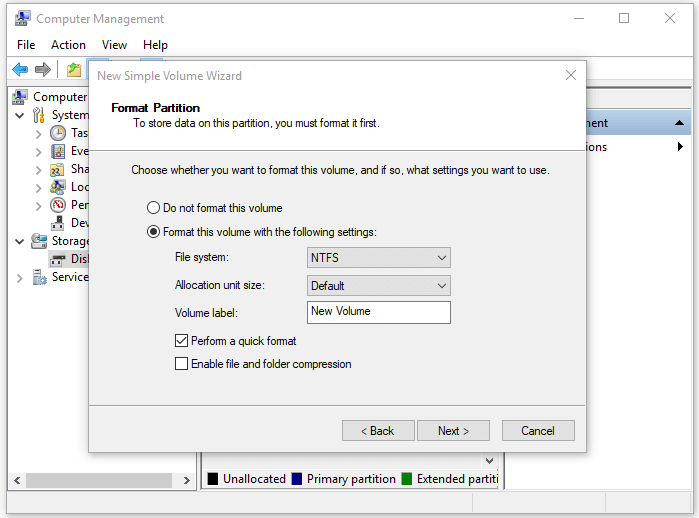
Step 5. Click "Finish" when Disk Management shows it has created a new volume on your hard drive.
Fix 4. Change Hard Drive Letter to Fix Not Showing Disk with Drive Letter Conflict
Applies to: Fix hard drive not showing up in File Explorer error caused by conflicted drive letter or hard drive has no drive letter.
When the drive letter of your hard drive conflicts with another drive letter on the computer, the hard drive will show as New Volume in Disk Management. As a result, it won't show up in File Explorer.
So, the best way to make your hard drive show up is to change its drive letter. Here are the steps to do that:
Step 1. In Disk Management, right-click the hard drive marked as New Volume or the partition doesn't have a drive letter.
Step 2. Select "Change Drive Letter and Paths". In the new window, click "Change".
Step 3. Assign a new drive letter to your external or internal hard drive and click "OK".
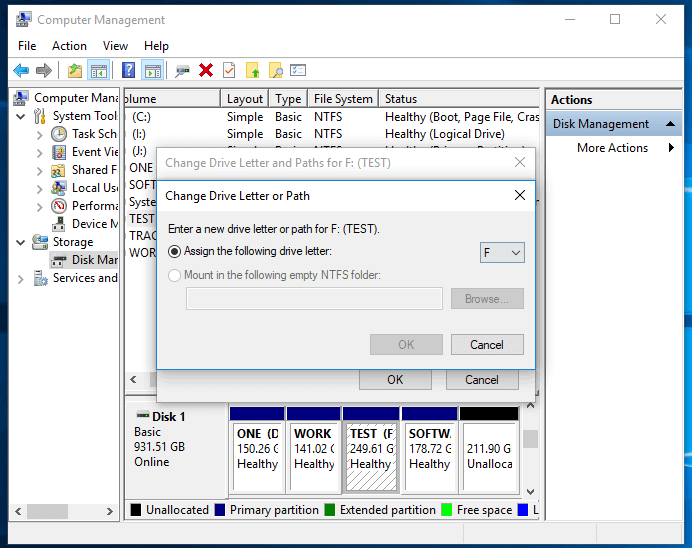
Fix 5. Update Disk Drivers to Fix Hard Drive Not Showing Up Due to Outdated Disk Driver
Applies to: Fix the hard drive not showing up in File Explorer. The hard disk has a yellow exclamation mark in Disk Management.
If your hard drive has a yellow exclamation mark in Disk Management under the Disk Driver section, it means that the drive driver is outdated. As a result, the hard drive will not appear in Windows File Explorer or Disk Management.
The only solution is to update the device driver, and here are the steps for you to do that:
Step 1. Right-click "This PC" and choose "Manage".
Step 2. Click "Device Manager" then expand "Disk drives".
Step 3. Find and right-click the problematic external or internal drive and select "Update driver".
Step 4. Click "Search automatically search for driver software online".
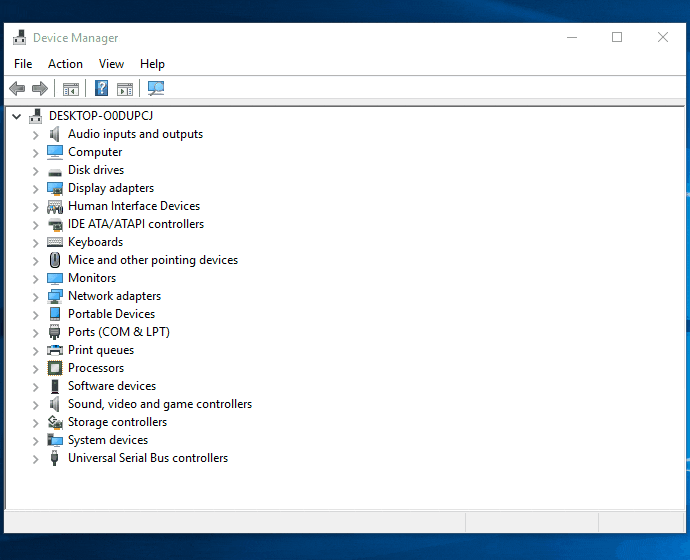
Wait for the driver to be updated, then reboot your computer. Afterward, you can check whether the hard drive shows up or not.
Fix 6. Initialize Disk, Create Volume, and Enable in BIOS to Fix New Hard Drive Not Showing Up
Applies to: Fix new hard drive is not showing up in File Explorer issue.
Most of the time, if your hard drive is a brand-new disk, you need to initialize it first. Then, create a new partition on it and enable it in BIOS. By doing so, you'll make your new hard drive show up on Windows 10/8/7.
#1. Initialize Disk and Create Volume on New Hard Drive
Step 1. Right-click "This PC" (in Windows 10) and choose "Manage".
Step 2. Go to "Disk Management", right-click your new hard disk, and choose "Initialize Disk".
Step 3. Select the disk, choose MBR or GPT as its partition style, and click "OK" to start.
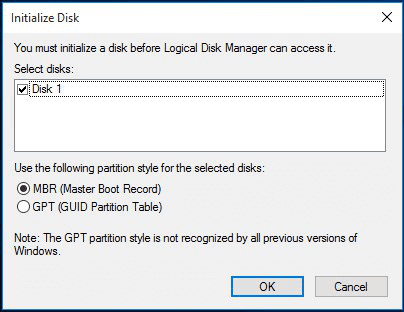
Step 4. Right-click on the unallocated space in your new hard drive and select "New Simple Volume...".
Step 5. Set the volume size, drive letter, and file system as NTFS for the new hard drive.
Step 6. Click "Finish" when the process completes.
#2. Enable Hard Drive in BIOS
If the hard drive is disabled in BIOS, the OS won't be able to detect it, resulting in it not showing up in Windows. Hence, checking whether your hard drive is disabled in BIOS is necessary.
Step 1. Restart your computer and press F2 or Del until you enter BIOS.
Step 2. Use the arrow keys on your keyboard to choose "Integrated Peripherals" and hit "Enter".
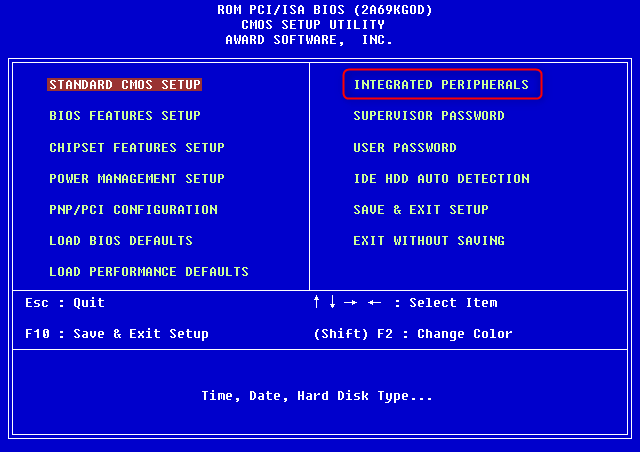
Step 3. Use the arrow keys to select "USB Controller".
If it is disabled, change the option to "Enabled".

Step 4. Save and exit BIOS.
Afterward, restart your computer and see whether your hard drive is detected.
You May Also Be Interested In:
If you are having a similar issue on a USB flash drive or external disk, all the provided fixes above can help. You can also follow the links below for help.
Fix External Hard Drive Not Showing Up in 4 Ways
Works to: Fix external hard drive not showing up or not detected by Windows PC error.
Mostly, when your external hard drive fails to show up on Windows 10/8/7, first, connect your new hard drive correctly to your computers.
Then, you can pick an appropriate fix to make your external hard drive show up on your PC and work normally again:
| Workable Solutions | Step-by-step Troubleshooting |
|---|---|
| Fix 1. Change the USB Cable/USB Port | If the old one is damaged, replace it with a new USB one and connect the drive to the PC...Full steps |
| Fix 2. Format External Hard Drive to NTFS/exFAT | Keep the external hard drive connected to the PC, and Open Disk Management...Full steps |
| Fix 3. Reinstall External Hard Drive Disk Driver | Right-click the Windows icon and choose Device Manager, and expand Disk drives...Full steps |
| Fix 4. Update Universal BUS Controller Drivers | Go to This PC > Manage > Device Manager, and expand Universal Serial Bus controllers...Full steps |
So, the solutions are quite clear now. Just follow the right method to make your new hard drive detectable and show up on your computer again.
Fix 1. Change the USB Cable, USB Port, and Reconnect the External Hard Drive
Change the connection between the external hard drive and the computer, and you can make the external disk show up.
Step 1. If the old one is damaged, replace it with a new USB one and connect the drive to the PC.
Step 2. Change the USB port if the external hard drive doesn't show up, and reconnect the drive to the PC.
Step 3. Switch and connect the external hard drive to another computer.
If nothing shows up, the external hard drive has a detection issue on your PC. Try the following 3 fixes to make the drive show up again.
Fix 2. Format External Hard Drive to NTFS/exFAT
If the external hard drive displays as RAW or "*Other", it won't show up correctly on your computer.
Step 1. Keep the external hard drive connected to the PC.
Step 2. Open Disk Management and right-click the external hard drive with the RAW or unknown file system.
Step 3. Select "Format" and set "NTFS" or "exFAT" for the external hard drive.
Step 4. Select "OK" to finish the formatting.
If you lost files after formatting the external hard drive, turn to EaseUS Data Recovery Wizard for help. It will scan and find all your lost files.
Fix 3. Reinstall Disk Drivers - Fix the External Hard Drive Not Showing UP with a Yellow Exclamation
Applies to: Fix external hard drive not showing up and has a yellow exclamation mark in Disk Management.
When the external hard drive has an outdated driver, it won't show up in File Explorer. It appears with a yellow exclamation under the Disk driver section.
The only solution is to update the device driver, and here are the steps for you to do that:
Step 1. Right-click the Windows icon and choose "Device Manager".
Step 2. Expand "Disk drives" and find your external hard drive.
Step 3. Right-click the problematic external drive and select "Uninstall device".
Step 4. Click "OK" to confirm. Restart your computer and reconnect the external hard drive to your PC.
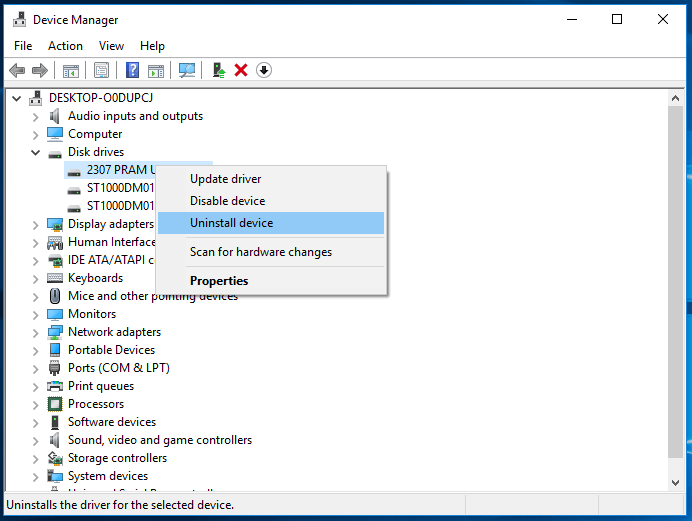
Share this post with your friends and help more people learn how to solve an external hard drive not showing up on a Windows PC.
Fix 4. Update Outdated BUS Controller Drivers in the External Hard Drive
Applies to: Fix an external hard disk not showing up or not detected by a Windows PC.
If you notice the external hard drive works with one computer but fails to be detected by another, you can try to update the USB Controller driver of the computer in which the hard drive is not showing up.
Step 1. Right-click "This PC" and choose "Manage".
Step 2. Click "Device Manager" then expand "Universal Serial Bus controllers".
Step 3. Right-click "USB Root Hub (USB3.0)" and select "Update driver".
Step 4. Choose "Search automatically for updated driver software" and restart your computer.
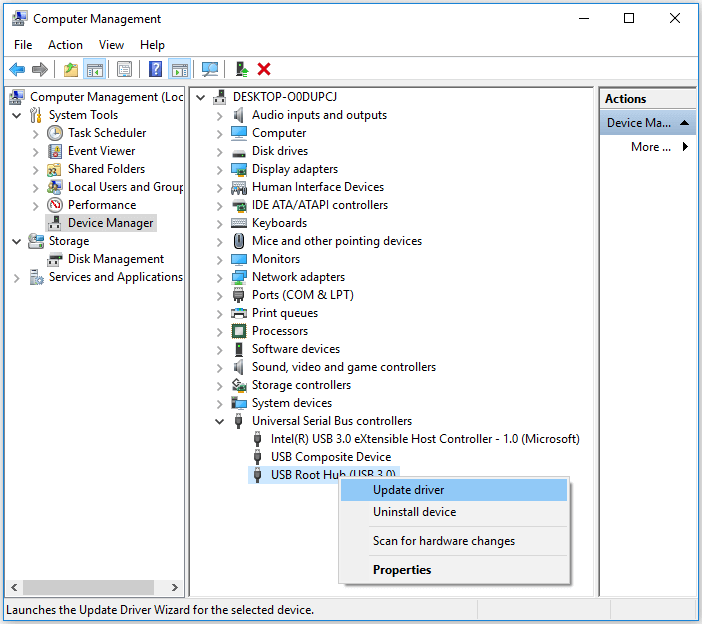
More Help:
If the above fixes don't fully resolve your issue of the external hard disk not showing up, don't worry. You may get further help from the tutorial page below. Check it out to find the best solution for your issue.
11 Fixes for Toshiba External Hard Drive Not Showing Up
It might happen that a Toshiba external hard drive is not working in Windows, be it not showing up, not recognized, or not showing files. Follow along to identify your situation and fix your Toshiba hard drive.
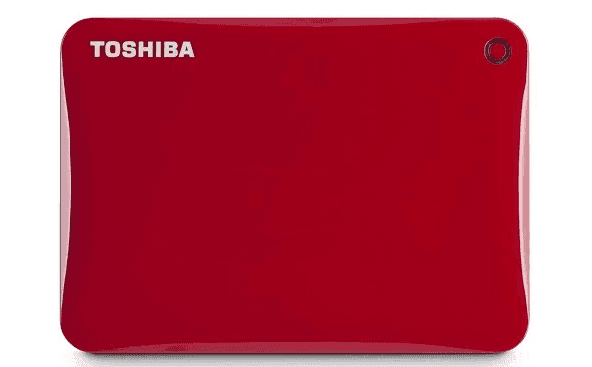
Bonus Tips to Fix Hard Drive Not Showing Files
Sometimes, a hard drive may not show files, although the files exist. Note that the files that are missing on the hard drive are still recoverable. Files disappearing could be caused by the following reasons:
- Files are hidden by malware or a virus
- Files are deleted accidentally
- The computer does not recognize the file system of the hard drive
To fix these issues, you can follow the following steps:
Step 1. Recover hidden or removed files from the hard drive.
Reliable EaseUS Data Recovery Wizard can help you restore all your hard drive files in only 3 steps, as shown in 👉Fix 3. Restore Data and Create New Partition.
Refer to this video tutorial to solve the hard drive not showing up files issue:

Step 2. Run antivirus or malware-clear software to remove all viruses and malware.
Step 3. Format the hard drive to restore its full capacity and set NTFS as its file system.
You are now good to use this drive and save files on it again. For more details, check out the article about the pen drive not showing files for help.
The Ending Line
In this guide, we explained to you why your hard drive or external hard drive is not showing up on your Windows PC. We also provided solutions and fixes to help you make the used external or internal hard drives and new hard drives show up again without losing any data.
Sometimes, you may encounter the same issue on a USB drive, SD card, etc. These fixes are applicable to resolve this error on USB, SD card, etc., devices.
FAQs About Hard Drive Not Showing Up
In addition to new or used hard drives not showing up issues in File Explorer or Disk Management, we will try and answer some of your most asked questions about these issues.
If you have any questions, the following should answer them for you:
1. What do I do if my internal hard drive is not detected?
As described on this page, there are many ways you can follow to fix the internal hard drive not detected issue.
For a new hard drive, initialize the disk and then create partitions on the drive.
For a used hard drive, try these tips shown on this page in Part 1:
- Change the hard drive letter;
- Recover lost partition data and create new partitions;
- Update the hard drive driver;
- Check the hard drive connection and enable it in BIOS.
2. How do I get Windows 10 to recognize a new hard drive?
Similar to the solutions provided on this page, when a new hard drive is not detected or recognized on Windows 10, you should mainly follow the following tips:
Check new hard drive connection > Initialize new hard drive and create partition > Update drive letter > Enable it in BIOS.
3. Why is my hard drive not showing up on Mac?
Similar to the hard drive not showing up on Windows computers, the reasons why your hard drive is not showing up on Mac are pretty much the same.
Here is a list of why a hard drive is not showing up on Mac:
- Hard drive connection error
- Settings in Desktop, Finder
- USB port issue
- Hard drive corrupted
- macOS and firmware are outdated
- ...
For a step-by-step guide, you may follow the USB flash drive not showing up on Mac to troubleshoot the hard drive not detected on Mac issue and make the drive detectable again.
Was This Page Helpful?
Brithny is a technology enthusiast, aiming to make readers' tech lives easy and enjoyable. She loves exploring new technologies and writing technical how-to tips. In her spare time, she loves sharing things about her game experience on Facebook or Twitter.
Approved by Mahesh Makvana
Mahesh is an experienced computer tech writer. He's been writing tech how-to guides for about 8 years now and has covered many topics. He loves to teach people how they can get the most out of their devices.
Related Articles
-
How to Transfer C Drive to New SSD in Windows 11/10/8/7
![author icon]() Jerry/Dec 01, 2025
Jerry/Dec 01, 2025 -
Hard Drive Not Showing Files Though They Still Exist
![author icon]() Jean/Dec 12, 2025
Jean/Dec 12, 2025 -
[Fixed] External Hard Drive Not Showing Up in Disk Management on Windows 10/11
![author icon]() Larissa/Jul 04, 2025
Larissa/Jul 04, 2025 -
Fix WD External Hard Drive Not Showing Up/Recognized Error [2025 Tutorial]
![author icon]() Tracy King/Dec 03, 2025
Tracy King/Dec 03, 2025

